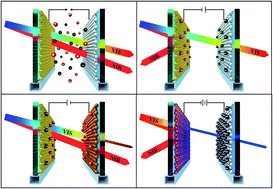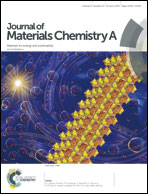A dual band electrochromic device switchable across four distinct optical modes†
Abstract
The paper reveals a dual-band electrochromic device capable of selectively controlling the transmitted sunlight in the visible and near-infrared regions. It exploits the peculiar spectro-electrochemical features of vanadium-modified titanium oxide colloidal nanocrystals, which exhibit a distinctive electrochromic response at visible wavelengths upon the application of a small cathodic potential. They have been used as an active electrode in a sandwich cell in combination with a nanocrystalline tungsten oxide layer, which indeed allows selective control over the incoming near-infrared radiation at low applied potentials, until turning into a deep blue colored coating at higher potentials. These two coatings have been conveniently combined to realize an electrochromic device capable of separately operating over four different optical regimes, namely, fully transparent, VIS blocking, NIR blocking, and VIS + NIR blocking. Great benefits are anticipated in the field of glazing elements for buildings and transportation, where the solution proposed here may pave the way for the implementation of a novel class of “zero-energy” smart windows that self-adapt to both external climatic conditions and interior visual and thermal comfort requirements.



 Please wait while we load your content...
Please wait while we load your content...